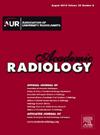推进神经血管成像:头颈部超高分辨率光子计数检测器CT血管成像的重建核优化和量子迭代重建。
IF 3.9
2区 医学
Q1 RADIOLOGY, NUCLEAR MEDICINE & MEDICAL IMAGING
引用次数: 0
摘要
目的:寻找头颈部超高分辨率(UHR)光子计数检测器CT (PCD-CT)血管造影的最佳重建参数,重点研究颅内动脉瘤的成像。材料和方法:本研究前瞻性地纳入了18例颅内动脉瘤患者。在临床PCD-CT扫描仪上以UHR模式获得CT血管造影。使用专用神经血管核(Hv48-89)的六个强度级别和量子迭代重建(QIR)级别1-4重建图像。确定所有重建的图像噪声、噪比和血管清晰度。定性图像质量由三名读者使用5点李克特量表进行评估,以获得最佳表现的重建。动脉瘤穹窿和颈部大小由两名读取器独立测量,以评估读取器间的可靠性。结果:共纳入18例患者,平均年龄64.3岁±15 [SD],男性5例。三个核(Hv56、Hv64、Hv72)在定量分析中表现最佳。定性分析表明,在每个评估类别中,所有内核都一致倾向于QIR水平为4 (p结论:QIR水平为4的Hv72内核被证明是评估配置中CTA参数的最佳组合。本研究结果可为优化PCD-CT神经血管成像方案提供参考。本文章由计算机程序翻译,如有差异,请以英文原文为准。
Advancing Neurovascular Imaging: Optimization of Reconstruction Kernel and Quantum Iterative Reconstruction for Ultra-high-resolution Photon-Counting Detector CT Angiography of the Head and Neck
Rationale and Objectives
To find the optimal reconstruction parameters for ultra-high-resolution (UHR) photon-counting detector CT (PCD-CT) angiography of the head and neck, with a special focus on imaging intracranial aneurysms.
Material and Methods
18 patients with intracranial aneurysms were prospectively enrolled in this single-center study. CT angiograms were acquired in UHR mode on a clinical PCD-CT scanner. Images were reconstructed with six strength levels of a dedicated neurovascular kernel (Hv48–89) and with quantum iterative reconstruction (QIR) levels 1–4. Image noise, contrast-to-noise ratio, and vessel sharpness were determined for all reconstructions. Qualitative image quality was assessed by three readers using a 5-point Likert scale, for the best-performing reconstructions. Aneurysm dome and neck sizes were independently measured by two readers to assess inter-reader reliability.
Results
18 patients (mean age, 64.3 years ± 15 [SD], 5 men,) were evaluated. Three kernels (Hv56, Hv64, Hv72) were identified as best performing in the quantitative analysis. The qualitative analysis demonstrated a consistent preference for QIR level 4 across all kernels in each evaluated category (P<0.001). Hv72 was the most frequently preferred, although it exhibited a higher incidence of image artifacts compared to the other kernels. Inter-reader reliability was high for dome measurements—especially on UHR images—while neck measurements showed greater variability.
Conclusion
Hv72 kernel with QIR level 4 proved to be the optimal combination of CTA parameters among the configurations evaluated. Our results could provide reference for protocol optimization on PCD-CT for neurovascular imaging.
求助全文
通过发布文献求助,成功后即可免费获取论文全文。
去求助
来源期刊

Academic Radiology
医学-核医学
CiteScore
7.60
自引率
10.40%
发文量
432
审稿时长
18 days
期刊介绍:
Academic Radiology publishes original reports of clinical and laboratory investigations in diagnostic imaging, the diagnostic use of radioactive isotopes, computed tomography, positron emission tomography, magnetic resonance imaging, ultrasound, digital subtraction angiography, image-guided interventions and related techniques. It also includes brief technical reports describing original observations, techniques, and instrumental developments; state-of-the-art reports on clinical issues, new technology and other topics of current medical importance; meta-analyses; scientific studies and opinions on radiologic education; and letters to the Editor.
 求助内容:
求助内容: 应助结果提醒方式:
应助结果提醒方式:


